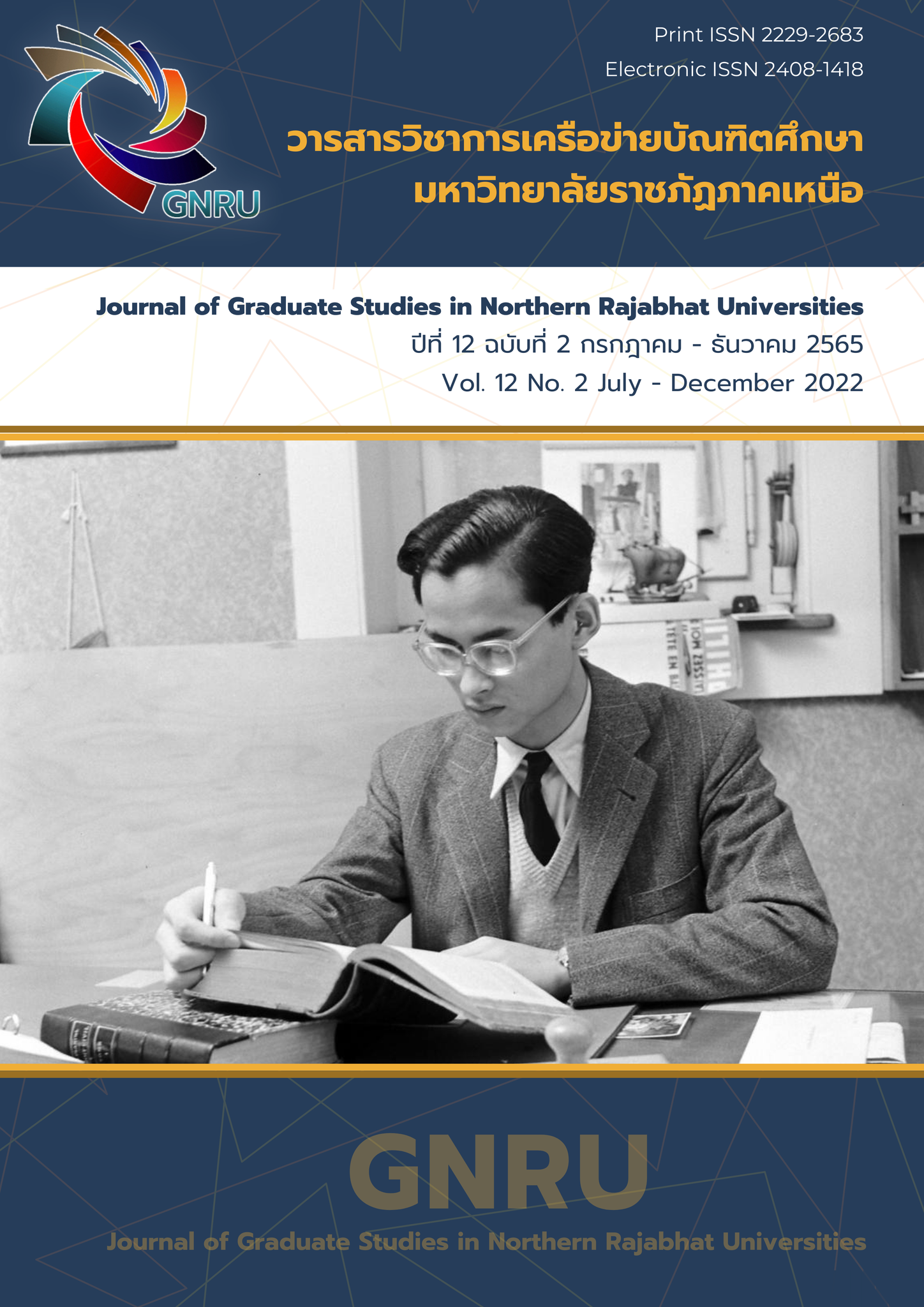Enhancing Social Cohesion in the Aging Society with an Interdisciplinary Curriculum about Knowledge Integration of Local Culture to Live together in a Quality Society for Prathomsuksa 1-3 Students.
Main Article Content
Abstract
The purposes of this research were to study needs, develop a curriculum, experiment on the curriculum, compare social coercion, and evaluate the curriculum. The research and development consisted of 4 phases. First, the needs of 49 people involved in the curriculum and culture were studied by using an interview schedule. Second, the curriculum was prepared and examined by 10 experts by group discussion. Third, the curriculum was tried out by developing 30 teachers with curriculum and supporting documents, and training 6 teachers with 100 students in a one -group pre - posttest design. Fourth, the curriculum was evaluated with teachers and 106 students by using an assessment form. The data were analyzed by using mean, standard deviation, and T-test. The results showed that the curriculum was necessary due to family changes and social studies, but learning subject areas had little relevant content focusing on measuring knowledge. The curriculum consisted of name, code, class, subject group, credits, time, leadership, vision, principles, aims, performance, desirable characteristics, structure, course description. learning outcomes, content, class time, activity management guidelines, learning resources, measurement and evaluation. The efficiency of the curriculum was 83.22/87.53, and the overall and individual satisfaction was at a high level. The students’ satisfaction after using the curriculum was significantly higher than before at the 0.01 level. Both the overall and individual aspects were at a high level.
Article Details
References
กระทรวงศึกษาธิการ. (2560). หลักสูตรแกนกลางการศึกษาขั้นพื้นฐาน พุทธศักราช 2551. กรุงเทพฯ: พัฒนาคุณภาพวิชาการ (พว).
คณะอนุกรรมการปรับปรุงเกณฑ์มาตรฐานหลักสูตรระดับอุดมศึกษา. (2549). หลักสูตรสหวิทยาการ (Interdisciplinary Curriculum) พหุวิทยาการ (Multidisciplinary Curriculum) และหลักสูตรบูรณาการ (Integrated Curriculum). สืบค้นเมื่อ 9 มีนาคม 2564, จาก www.ubu. ac.th/web/Files _up/46f2014100214483734.docx.
คะนึงนิจ ป้อมหิน. (2556). การพัฒนาหลักสูตรรายวิชาเพิ่มเติมกลุ่มสาระการเรียนรู้สังคมศึกษา ศาสนาและวัฒนธรรม เรื่อง ตามรอยพระอริยสงฆ์เจ้า ในอำเภอปลาปาก ชั้นประถมศึกษาปีที่ 3 โรงเรียนบ้านนาดอกไม้ สำนักงานเขตพื้นที่การศึกษาประถมศึกษานครพนม เขต 1. วิทยานิพนธ์ปริญญาครุศาสตรมหาบัณฑิต สาขาวิชาหลักสูตรและการสอน บัณฑิตวิทยาลัย มหาวิทยาลัยราชภัฏสกลนคร.
จันทร์ดี แสงห้าว. (2558). การพัฒนาหลักสูตรรายวิชาเพิ่มเติมเพื่อเสริมสร้างทักษะการอ่านอย่างมีวิจารณญาณและการใฝ่รู้ ของนักเรียนชั้นมัธยมศึกษาตอนต้น. วิทยานิพนธ์ปริญญาครุศาสตรดุษฎีบัณฑิต สาขาวิชาหลักสูตรและการสอน มหาวิทยาลัยราชภัฏมหาสารคาม.
ปราโมทย์ ประสาทกุล. (2557). สถานการณ์ผู้สูงอายุไทย พ.ศ. 2556. กรุงเทพฯ: อมรินทร์พริ้นติ้งแอนด์พลับชิง จำกัด (มหาชน).
พูนสุข เวชวิฐาน. (2557). ทฤษฎีครอบครัวเบื้องต้น. กรุงเทพฯ: ภาพพิมพ์.
มงคล ยะภักดี. (2564). ระเบียบวาระแห่งชาติเรื่อง สังคมสูงอายุ. สืบค้นเมื่อ 21 สิงหาคม 2564, จาก https:// www.gotoknow.org/posts/676782.
ศุภชัย ปิติกุลตัง. (2563). การประชุมวิชาการอนามัยครอบครัวแห่งชาติครั้งที่ 9 เรื่อง “ครอบครัวไทยในยุคเปลี่ยนผ่านทางสังคม (Thai Family in Social Transition). สืบค้นเมื่อ 8 พฤษภาคม 2563, จาก https:// iptv.mahidol.ac. th/topic/79324.
ศิรินทรา พลซา. (2562). การพัฒนาหลักสูตรรายวิชาเพิ่มเติม “สนุกคิดกับสิ่งประดิษฐ์ทางวิทยาศาสตร์” เพื่อส่งเสริมทักษะการเรียนรู้และนวัตกรรมในศตวรรษที่ 21 สำหรับ นักเรียนชั้นประถมศึกษา ปีที่ 6 โดยจัดการเรียนรู้แบบสะเต็มศึกษา. วิทยานิพนธ์ปริญญาศึกษาศาสตรมหาบัณฑิต สาขาวิชาหลักสูตรและการสอน บัณฑิตวิทยาลัย มหาวิทยาลัยขอนแก่น.
สายฝน หล้าสุดตา. (2558). การพัฒนาหลักสูตรรายวิชาเพิ่มเติม กลุ่มสาระการเรียนรู้การงานอาชีพและเทคโนโลยี เรื่องการประดิษฐ์ผลิตภัณฑ์จากผ้าพื้นเมือง ชั้นมัธยมศึกษาปีที่ 2. วิทยานิพนธ์ปริญญาการศึกษามหาบัณฑิต สาขาวิชาหลักสูตรและการสอน มหาวิทยาลัยมหาสารคาม.
สำนักงานสถิติแห่งชาติ. (2561). พฤติกรรมการดูแลสุขภาพของประชากรไทยขึ้น โดยใช้ข้อมูลจาก การสำรวจอนามัยและสวัสดิการ. กรุงเทพฯ: สำนักงานสถิติแห่งชาติ.
Allan C. Ornstein, Francis P. Hunkins. (1988). Curriculum foundations, Principles, and Issues. Prentice Hall.
Dougherty, D.D. (1999). Dopamine transporter density in patients with attention deficit hyperactivity disorder. 1999 Dec 18-25; 354 (9196): 2132-3.doi: 10. 1016/S0140-6736(99)04030-1.
Erera, P. I.. (2002). Family Diversity: Continuity and Change in the Contemporary Family. The Journal of Sociology & Social Welfare, 29(3), Article 17. Available at: https://scholarworks. wmich. edu/jssw/ vol29 /iss3/17.


